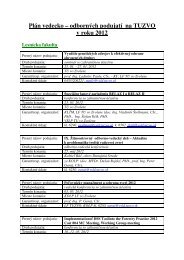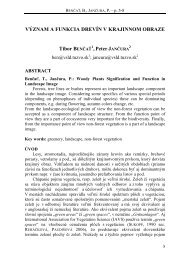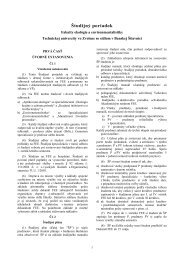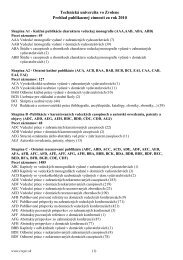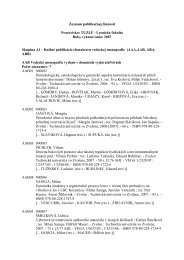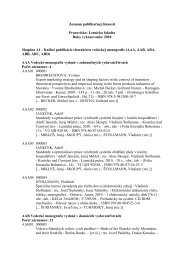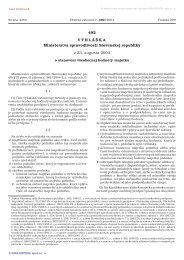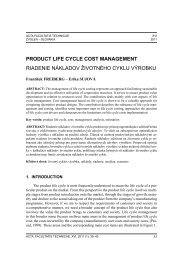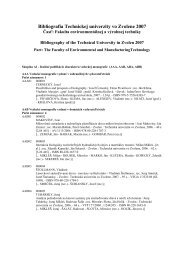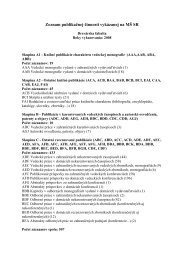35DISCUSSIONThe ionising radiation exerts profound effectson the mucous lining of the gastrointestinal tract: asa result of its impact on the dividing enterocytes inthe crypts the continuous replacement of the dyingand desquamating cells on the top of the enteric villiis interrupted. This state leads to the interruptionof the regeneration processes of the gut mucousand to the loss of its functions. Clinically, this statemanifests in diarrhea and in a subsequent cachexia.The damage of the barrier functions of the intestinalmucous caused by the high radiosensitivityof the enterocytes, along with the disruption of theimpermeability of blood capillaries conditioned bythe high radiosensitivity of endothelial cells belongto the typical symptoms of the radiation disease[10]. The increased permeability of blood capillariesleads to development of hemorrhagic diatesisas it was observed in our experiments on the eyesof the irradiated rats and on the presence of bloodydiarrhea.Microorganisms commonly present in the gastrointestinaltract penetrate after irradiation throughthe intestinal mucus and the damaged capillaries ofthe intestinal wall into the blood circulation, wherethey acts as antigens. In irradiated organisms,however, because of lymphopenia and monocytopeniacaused by radiation the immunoligicalresponse is strongly suppressed. This can lead tofurther reproduction of bacteria and to the developmentof bacteremia and of subsequent toxinemia.The prolonged depression of immunological reactionsas a result of radiation leucopenia leads tosepsis, followed by death of the animal.From the point of view of the early diagnosticsof the radiation disease the most important are thechanges in white blood cells. In our experiments inall irradiated individuals a statistically significantdecrease of the total number of leucocytes and anincrease of neutrophils in comparison with controlsoccurred. Shortly after irradiation leucopeniacharacterized by lymphopenia and neutrophiliawas observed. The changes in the white bloodpicture are caused not only by the damage of thebone marrow, but also of the lymphoid tissues withmyelopoetic functions, like thymus, the lymphaticnodes, and the Bursa fabricii in birds [6, 12]. Thelymphocytes, on the other hand, show a high degreeof direct radiosensitivity and their number inperipheral blood decreases as a result of their directextinction. The immunosuppressive effect of radiationcould be critical for the irradiated organism, asmuch it becomes sensitive not only to various infections,but also to the common microflora, whichleads to postradiation bacteremia [1].In the total number of erythrocytes as well asin the hemoglobin content a statistically non-significantincrease was recorded 3 days after irradiation.The increase of the hematocrit value wasin this time interval statistically significant. Startingwith the 6 th day after irradiation a statisticallysignificant increase in CPE was recorded, whichwas prolonged up to the 9 th day. The hemoglobincontent was increased still on the 6 th day after irradiation,however, on the 9 th day a marked decreaseof this parameter in comparison with controls occurred.The hematocrit values decreased only onthe 9 th day after irradiation. The following changesin the red blood picture are due to the high radiresistenceof the erythrocytes and also due to the factthat the body disposes with large reserves of theseblood cells deposited in the spleen and in liver[4, 7]. The anemia which belongs to the basic symptomsof the radiation disease manifest itself as thelatest of the hematological changes. The extent ofthe hypoplastic or aplastic anemia and the degreeof damage which are documented after irradiationdepend, except of the radiosensitivity of cells,also on the exposition dose and on the dose rate,the regeneration capacity of the cells, e.g. Subakovet al. [11] using chronical irradiation with a totaldose of 0.9 Gy of gamma-rays recorded an increaseof the number of reticulocytes in the peripheralblood, which is an evidence of an increased erythropoesisin the bone marrow. In the case of the doseapplied by us irreversible changes in the bone marrowcan be assumed, which leads to the developmentof the anemia described above. The normaltissue is replaced by the fat tissue which is unableto produce differenciated blood cells. Also the destructionof existing cells (karyorexis, karyolysis)and cytogenetic damage of cells occur (4).AcknowledgementsThe study was supported by the grant VEGANo. 1/2378/05 and by the grant No. MSM6215712402 from the Ministry of Education, Youthand Sports of the Czech Republic. The authorswish to thank for financial support of the project.
36REFERENCES1. BEŇOVÁ K., FALIS M., TOROPILA M., SEH-NALKOVÁ H., PASTVOVÁ L.: Influence of a singleγ-irradiation on rat microflora. Folia Microbiol.47 (4), 461–462 (2002).2. FALIS M., BEŇOVÁ K., TOROPILA M., SESZ-TÁKOVÁ E., LEGÁTH J.: Changes in the activityof selected adaptive enzymes in chicken liver aftersingle gamma irradiation. Bull. Vet. Inst. Pulawy 48,503–506, (2004).3. GAÁL, T.: Veterinary Clinical Laboratory Diagnostics(In Hungarian) SIK, Budapest, (1999).4. KLOKOV, D. I., ZAICHKINA, S. I., APTIKAEVA,G. F., AKHMADIEVA, A. K., ROZANOVA, O. M.,GANASSI, E. E.: Induction of Cytogenetic damageto rat bone marrow cells by combined exposure tochronic and acute gamma radiation. Genetika 33 (6):855–857 (1997).5. KUBÍČEK K., NOVÁK P., KOČIŠOVÁ A., RODLP.: Disinfection, Disinsection and Rat Control inSchemes, Tables And Figures. (In Czech) Veterinaryand Pharmaceutical University, Brno (Czech Republic)(2000).6. KVACHEVA, IUE., VLASOV, P. A.: The pathomorphologicalcharacteristics of the early necrobiosis ofthe myelokariocytes in an acute radiation lesion. Radiats-Biol-Radioecol.,37 (1): 76–81 (1997).7. MALHOTRA, N., RANI, N., RANA, K., MAL-HOTRA, R. K.: Radiation induced blood pathologyin chick-erythrocytes and related parameters. Exp.Pathol., 38, 241–248, (1990).8. MIKULA, I., PILIPČINEC, E., TKÁČIK, J., PISTL,J., HOLODA, E.: Veterinary Microbiology and Imunology– Practical Lessons. ( In Slovak) Príroda Publishers,Bratislava (Slovakia) (1985).9. MOROZ, B. B., DESHEVOI, J. B., LEBEDEV, V.G., LYRSHCHIKOV, A. V., VOROTNIKOVA, T.V.: Reaction of the haemopoetic system under longtermemotional stress developed after preliminarygamma-irradiation with low doses. Radiats-Biol-Radioecol.37 (4): 581–589 (1997).10. PROCHÁZKA, Z., DVOŘÁK, P.: Veterinary Radiobiologyand Radiation Hygiene. (In Czech) Veterinaryand Pharmaceutical University, Brno (CzechRepublic) (2002).11. SUBAKOV, K. V., MOROZ, B. B., SALIEVA,R. M., DESHEVOI, J. B., SOSNOVSKIJ, A. S.,KAŠMANOV, S. I., TOMILINA, I. V., PIROGOVA,G. V., JMATOV, E. A.: Combined effects of chronicalgamma-iradiation and of emotional stress onrats. Sechenov physiological journal, 81 (3), 41–49(1995).12. ŠKARDOVÁ, I., OJEDA, F.: Postradiation bonemarrow damage in chicken. Izotóptechnika, diagnosztika,37, 77–82 (1994).13. TOROPILA, M., AHLERS, I., AHLERSOVÁ, E.,ONDRAŠOVIČ, M., BEŇOVÁ, K.: The influenceof prolonged fasting on changes in the activity of selectedadaptive rat liver enzymes. Vet. Med. Czech.41, 41–44 (1996).14. ZUKHBAIA, T. M., EFIMOV, V. I.: Combined effectsof prolonged hypokinesia and ionizing radiationon the haematopoetic system and lymphatic organsof rats. Aviakosm-Ekolog. Med., 29 (5): 42–46(1995).
- Page 2 and 3: Acta FacultatisEcologiaeJournal of
- Page 4 and 5: OBSAH / CONTENTSISOL M., MICHALÍKO
- Page 6: 5ACTA FACULTATIS ECOLOGIAE, 16: Sup
- Page 12: 11ACTA FACULTATIS ECOLOGIAE, 16: Su
- Page 18 and 19: 17ACTA FACULTATIS ECOLOGIAE, 16: Su
- Page 20 and 21: 19are lower in ill patients compare
- Page 22: 21are considered as the most accura
- Page 25 and 26: 24- multimode cavities are usually
- Page 27 and 28: 26the load during its exposure to f
- Page 29 and 30: 28Tradescantia paludosa 02 test and
- Page 31 and 32: 30Tab. 5: Results of positive contr
- Page 34 and 35: 33ACTA FACULTATIS ECOLOGIAE, 16: Su
- Page 38 and 39: 37ACTA FACULTATIS ECOLOGIAE, 16: Su
- Page 40 and 41: 39222Rn is produced by radioactive
- Page 42 and 43: 41180160140this reason we also pick
- Page 44: 435001450400350hKz0,8h [m]300250200
- Page 47 and 48: 46deposit is that stripped in off-l
- Page 49 and 50: 48TruenessTrueness was determined i
- Page 51 and 52: 50MATERIAL AND METHODSChloroform (p
- Page 53 and 54: 52absorbance [a.u.]1,000,750,500,25
- Page 55 and 56: 54Tab. 1: Rrequirements determinati
- Page 57 and 58: 56Methods of VOC testing were set a
- Page 60 and 61: 59Tab. 6: ContinuedSamples withsurf
- Page 62 and 63: 61ACTA FACULTATIS ECOLOGIAE, 16: Su
- Page 64 and 65: 63One of the possible explanations
- Page 66 and 67: 65Ai - Ai-1 [Bq.m -3 ]86420-2-4-6-8
- Page 68 and 69: 67ACTA FACULTATIS ECOLOGIAE, 15: Su
- Page 70 and 71: 69BiodegradabilityThe great variety
- Page 72 and 73: 71degradation starts of late days,
- Page 74 and 75: 73Fig. 4 Treated (after 28 days of
- Page 76: 75parameters of the cutting process
- Page 80 and 81: 79Fraction: D (residual rest) prese
- Page 82: 81was not confirmed. Maximum of mer
- Page 85 and 86: 84Fig. 1 Schematic diagram of atomi
- Page 87 and 88:
86Alpha spectrometryAlpha spectrome
- Page 89 and 90:
8880007000y = 6622xR 2 = 0.939SIMS
- Page 92 and 93:
91ACTA FACULTATIS ECOLOGIAE, 16: Su
- Page 94 and 95:
93Gemer according to the German mod
- Page 96 and 97:
95Tab. 1 Results of the chemical an
- Page 98 and 99:
97Continuation of Tab. 2 Results of
- Page 100 and 101:
99Vlčia Dolina and from the reserv
- Page 102 and 103:
101ACTA FACULTATIS ECOLOGIAE, 16: S
- Page 104 and 105:
103mg.dm -3mg.dm -35,004,003,002,00
- Page 106 and 107:
105year and the average value repre
- Page 108 and 109:
107ACTA FACULTATIS ECOLOGIAE, 16: S
- Page 110 and 111:
109Sample site 1 Sample site 2 Samp
- Page 112 and 113:
111As for the sampling time (Fig. 5
- Page 114 and 115:
113ACTA FACULTATIS ECOLOGIAE, 16: S
- Page 116 and 117:
115Typha latifolia, Carex sp., Scir
- Page 118 and 119:
117conditions for decomposition of
- Page 120 and 121:
119ACTA FACULTATIS ECOLOGIAE, 16: S
- Page 122 and 123:
121from the background (derived fro
- Page 124 and 125:
12311. PETROVSKÝ, E., ELWOOD, B.:
- Page 126 and 127:
125ACTA FACULTATIS ECOLOGIAE, 16: S
- Page 128 and 129:
1272.52.0Correlation coefficient 0,
- Page 130 and 131:
129ACTA FACULTATIS ECOLOGIAE, 16: S
- Page 132 and 133:
131RESULTS AND DISCUSSIONTable 2 gi
- Page 134 and 135:
133ACTA FACULTATIS ECOLOGIAE, 16: S
- Page 136 and 137:
135V-1 BOREHOLEThe courses of 222 R
- Page 138 and 139:
137AV-2 (40m) 2006A ( 222 Rn) [kBq/
- Page 140 and 141:
139soaks into the soil, another par
- Page 142 and 143:
141ACTA FACULTATIS ECOLOGIAE, 16: S
- Page 144 and 145:
143Fig. 2 The continuous monitoring
- Page 146 and 147:
145Indoor radon activity concentrat
- Page 148 and 149:
147ACTA FACULTATIS ECOLOGIAE, 16: S
- Page 150 and 151:
149Fig. 1 Podlipa dump-fieldCanada)
- Page 152 and 153:
151concentrations of Fe. Cu. Cd. Ni
- Page 154 and 155:
153DUMP-FIELDREFERENCE SITEppm15001
- Page 156 and 157:
155Fig. 5 Compression of wood forma
- Page 158 and 159:
157decrease in the following order:
- Page 160 and 161:
159ACTA FACULTATIS ECOLOGIAE, 16: S
- Page 162 and 163:
161SPECIFIC EXAMPLES OFFACTORS THAT
- Page 164 and 165:
163ACTA FACULTATIS ECOLOGIAE, 16: S
- Page 166 and 167:
165The methods developed to incorpo
- Page 168 and 169:
167The effects of wind on ozone con
- Page 170 and 171:
169Fig. 6 Mean total and stomatal f
- Page 172 and 173:
171transport modelling in North Ame
- Page 175:
Acta Facultatis Ecologiae, Volume 1



